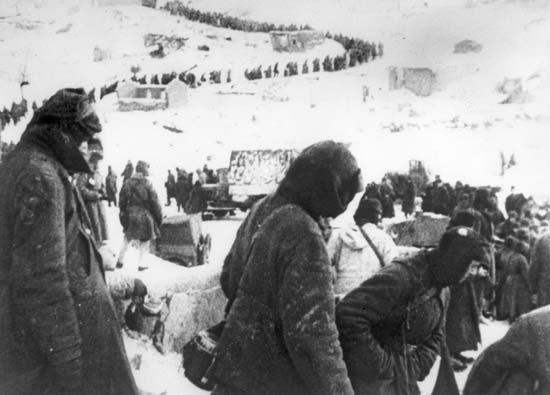
On 31 January the Soviets captured the commander of the 6th Army, Field Marshal Fredrich Paulus – the highest ranking of the 24 German generals who surrendered at Stalingrad. Two days later the remaining German forces in Stalingrad capitulated.
The loss of the 6th Army – an elite fighting force of the German army – was catastrophic enough. It was the biggest and most traumatic defeat in German military history and the myth of the invincible Wehrmacht was gone forever. But the overall strategic picture was even worse. By the end of the Stalingrad campaign Germany and its Axis allies on the Eastern Front had suffered casualties of a million and a half dead, wounded and captured. Nearly 50 divisions – almost the whole of five armies – had been lost. In the Caucasus, the German armies beat a rapid retreat north and barely escaped entrapment themselves. In the central sector, in front of Moscow, German Army Group Centre survived a major Soviet offensive launched simultaneously with the one at Stalingrad, but took heavy casualties and the threat of renewed Russian attack remained. In the north the Germans still surrounded Leningrad, as they had done since 1941, but in January 1943 the land blockade was breached and it was only a matter of time before the siege of the Soviet Union’s second city would be completely lifted. By spring 1943 the Germans were outnumbered two to one on the Eastern Front and outgunned many more times over. In the summer the Germans attempted to stabilise their defensive position by launching a great tank offensive at Kursk in the central sector, but this was another battle they lost, and it was one from which their famed Panzer forces never recovered.
The Soviets paid a high price for their victories. The Stalingrad campaign alone cost an estimated 2.5 million casualties. But no-one, either at the time or subsequently, seriously doubted that it was worth it. The Soviet victory at Stalingrad was the turning point in the war on the Eastern Front and the Eastern Front was the main front of the Second World War. More than 80 per cent of all combat during the Second World War took place on the Eastern Front.
The Germans suffered in excess of 90 per cent of their total war losses on the Eastern Front: 600 divisions destroyed by the Soviets; ten million dead, wounded, missing or captured. As the war progressed the western Allied contribution to the land war in Europe grew proportionately. Following the D-Day landings of June 1944, the American, British, Canadian and other allies deployed a two million strong force in France against about a million German defenders. However, even in summer 1944 there were still twice as many Germans serving on the Eastern Front, as in western theatres. The Germans blamed their defeat at Stalingrad on the vagaries of the weather, on the logistical difficulties of operating in the vast expanses of Russia, and, above all, on the seemingly inexhaustible Soviet manpower reserves. After the war, but not at the time, the favourite sport of retired German generals was attacking Hitler for his meddling in military affairs and his tactical and strategic errors in relation to Stalingrad and other campaigns.
Soviet propagandists, on the other hand, depicted Stalingrad as a triumph for the Soviet socialist system. The Soviet Union, they argued, had out-produced, out-fought and out-lasted Nazi Germany. Underlying that victory, they argued, was a superior socialist economic system, a dynamic political and military leadership and, above all, a people united in their determination to resist Nazi invasion, conquest and occupation.